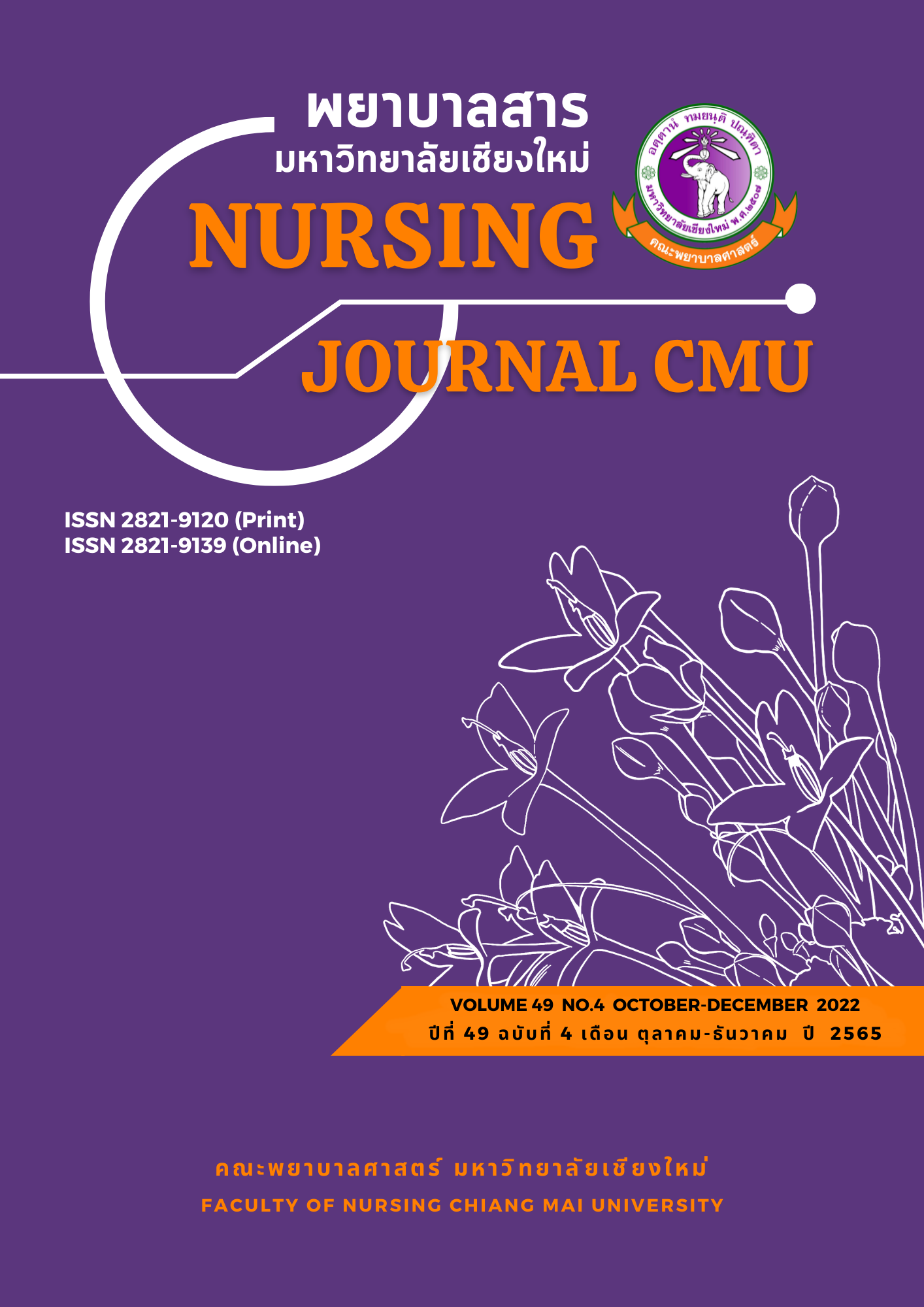The Model Development of a New Normal for Diabetes Mellitus and Hypertensive Clinics to Promote Health Literacy in the Prevention and Control of Coronavirus 2019
Keywords:
Diabetes mellitus and hypertension, New normal, Health literacy, Coronavirus 2019, Infection control and preventionAbstract
This research and development aimed to determine the health literacy (HL) of patients with diabetes mellitus (DM) and hypertension (HT) in relation to the prevention and control of Coronavirus 2019 (COVID-19) and to develop a new normal model of DM and HT clinics to promote HL in COVID-19 prevention and control. The research methodology consisted of 2 phases: Phase 1 - situation analysis; samples were 2,201 DM and HT patients and 20 health personnel; and Phase 2 - the development a new normal DM and HT clinic model to promote HL in COVID-19 prevention and control; samples were 11 specialists. The instruments consisted of a self-assessment questionnaire for COVID-19 HL and semi-structured interviews. Data were analyzed using descriptive statistics and content analysis.
The results showed that the samples had HL in COVID-19 prevention and control at moderate levels (mean = 29.98, SD = 10.28). Positive effects were found in terms of improving disease control and increasing family involvement in patient care. Negative effects were reported in terms of inaccessibility to health services, deviation from self-care, symptoms according to COVID infection, and psychological problems. The new normal model for DM and HT clinics to improve HL in COVID-19 prevention and control consists of provision of services, health workers, access to essential treatments and medical equipment, and health information. Patients with poor to moderate HL receive an intensive HL program, close monitoring, and family involvement. Those with higher HL receive informational support and continuous monitoring.
The new normal health service covers all epidemic stages of COVID-19 or emerging diseases to promote infection control in DM and HT patients.
References
Aekplakorn, W., Puckcharern, H., Thaikla, K., & Satheannoppakao, W. (2014). The 5th Thai national health examination survey. Nonthaburi: Health System Research Institute. (in Thai)
Bloom, B. S., Madaus, G. F., & Hastings, J. T. (1971). Handbook on formative and summative evaluation of student learning. New York: McGraw-Hill.
Daniel, W. (1999). Biostatistics: A foundations for analysis in the health sciences (7th ed.). New York: John Wiley & Sons.
Department of Disease Control, Ministry of Public Health. (2022). COVID-19 situation in Thailand. Retrieved from https://ddc.moph.go.th/covid19-dashboard/
Finbråten, H. S., Guttersrud, Ø., Nordström, G., Pettersen, K. S., Trollvik, A., & Wilde-Larsson, B. (2020). Explaining variance in health literacy among people with type 2 diabetes: The association between health literacy and health behaviour and empowerment. BMC Public Health, 20(1), 161. doi: 10.1186/s12889-020-8274-z
Goggins, K. M., Wallston, K. A., Nwosu, S., Schildcrout, J. S., Castel, L., Kripalani, S., & Vanderbilt Inpatient Cohort Study (VICS). (2014). Health literacy, numeracy, and other characteristics associated with hospitalized patients' preferences for involvement in decision making. Journal of Health Communication, 19 (Suppl 2), 29–43. doi: 10.1080/10810730.2014.938841
Intarakamhang, U., Kammungkul, J., & Boocha, P. (2022). General health literacy scale for Thais and comparison between age groups. Heliyon, 8(5), e09462. doi: 10.1016/j.heliyon.2022.e09462
Liu, L., Qian, X., Chen, Z., & He, T. (2020). Health literacy and its effect on chronic disease prevention: Evidence from China’s data. BMC Public Health, 20, 690. doi: 10.1186/s12889-020-08804-4
Nutbeam, D. (2000). Health literacy as a public health goal: A challenge for contemporary health education and communication strategies into the 21st century. Health Promotion International, 15(3), 259-267. doi: 10.1093/heapro/15.3.259
Nutbeam, D. (2008). The evolving concept of health literacy. Social Science & Medicine, 67(12), 2072-2078. doi: 10.1016/j.socscimed.2008.09.050
Nutbeam, D. (2009). Defining and measuring health literacy: What can we learn from literacy studies? International Journal of Public Health, 54(5), 303-305. doi: 10.1007/s00038-009-0050-x
Okan, O., Bollweg, T. M., Berens, E. M., Hurrelmann, K., Bauer, U., & Schaeffer, D. (2020). Coronavirus-related health literacy: A cross-sectional study in adults during the COVID-19 infodemic in Germany. International Journal of Environmental Research and Public Health, 17(15), 5503. doi: 10.3390/ijerph17155503
Rheault, H., Coyer, F., Jones, L., & Bonner, A. (2019). Correction to: Health literacy in indigenous people with chronic disease living in remote Australia. BMC Health Service Research, 19(566). doi: 10.1186/s12913-019-4411-8
Richardson, S., Hirsch, J. S., Narasimhan, M., Crawford, J. M., McGinn, T., Davidson, K. W., … Zanos, T. P. (2020). Presenting characteristics, comorbidities, and outcomes among 5700 patients hospitalized with COVID-19 in the New York City area. The Journal of the American Medical Association, 323(20), 2052-2059. doi: 10.1001/jama.2020.6775
Siraprapasiri, P., & Lapbenjakul, S. (2020). Handbook of integrated, people-centered health services in new normal diabetic & hypertensive clinic for healthcare workers. Bangkok: The Printing Office of the War Veterans Organization of Thailand. (in Thai)
Tin, S. T. W., Vivili, P., Na'ati, E., Bertrand, S., & Kubuabola, I. (2020). Insights in public health: Covid-19 special column: The crisis of non-communicable diseases in the Pacific and the coronavirus disease 2019 pandemic. Hawaii Journal of Health & Social Welfare, 79(5), 147-148.
Woratanarat, T., Woratanarat, P., Wongdontri, O., & Chenphanitsub, M. (2015). A systematic review of situations and managment mechanisms of health literacy. Retrieved from https://kb.hsri.or.th/dspace/handle/11228/4291?locale-attribute=th (in Thai)
World Health Organization. (2010). Monitoring the building blocks of health systems: A handbook of indicators and their measurement strategies. Retrieved from https://www.who.int/workforcealliance/knowledge/toolkit/26.pdf
Downloads
Published
How to Cite
Issue
Section
License
Copyright (c) 2022 Nursing Journal

This work is licensed under a Creative Commons Attribution-NonCommercial-NoDerivatives 4.0 International License.
บทความที่ได้รับการตีพิมพ์เป็นลิขสิทธิ์ของวารสารพยาบาลสาร
ข้อความที่ปรากฏในบทความแต่ละเรื่องในวารสารวิชาการเล่มนี้เป็นความคิดเห็นส่วนตัวของผู้เขียนแต่ละท่านไม่เกี่ยวข้องกับมหาวิทยาลัยเชียงใหม่ และคณาจารย์ท่านอื่นๆในมหาวิทยาลัยฯ แต่อย่างใด ความรับผิดชอบองค์ประกอบทั้งหมดของบทความแต่ละเรื่องเป็นของผู้เขียนแต่ละท่าน หากมีความผิดพลาดใด ๆ ผู้เขียนแต่ละท่านจะรับผิดชอบบทความของตนเองแต่ผู้เดียว






